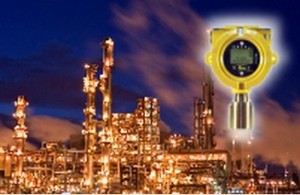Whether it’s catalytic gas sensor or an infrared one, the goal is the same to protect people and property from the dangers of explosions or fires due to combustible gases. Combustible gas sensors are a critical safety tool measuring the concentration of a specific gas. LPG (liquefied petroleum gas), ammonia, acetylene, and hydrogen are a few of the more common gases monitored and found in everything from factories, and refineries, to office buildings that use gas as a power source. Infrared and catalytic gas sensors measure a specific concentration and then compare it to a predetermined reference point. If the sensor’s response surpasses a pre-set or safe level, the alarm will sound either in the form of a noise, signal, or flashing light. Understanding how these sensors work is critical to ensure the utmost safety.
Catalytic Combustible Gas Sensors
Catalytic or electrocatalytic sensors are the most widely used passive gas detectors. They are based on the fact that combustible gases can be oxidized to produce heat. Once they reach a certain temperature, they will ignite and burn; however, in the presence of certain chemicals, the ignition temperature is much lower making the gas more susceptible to fire and explosions. A catalytic gas sensor contains a platinum coil and is heated when it comes into contact with gaseous reactants. This raises the temperature within the coil. The catalytic gas sensor will sound the alarm and alert people if that temperature change is within what is considered a dangerous range. With a lower price tag the catalytic gas sensor is often a more popular choice and has been in use for over 30 years. It does not sacrifice accuracy for cost.
Infrared Gas Sensors
Infrared gas sensors are considered an active technology because their signals are constantly sent and the results are up to the minute. They have a source and a detector designed to measure a gas’s light intensity at two specific wavelengths. The first wavelength is a gas’s absorption or active wavelength and the second is a reference or outside the absorption wavelength. An infrared sensor will sound the alarm if the difference in the two wavelengths is considered dangerous. One of the advantages of infrared sensors is that their signals will notify the user immediately if it fails and or needs repair.
Despite their different approaches to detecting combustible gases both of these sensors do the same thing, they keep people and property safe. With the precision and usability of combustible gas sensors constantly improving, it’s important to understand what is needed for your specific situation and then choose your device accordingly.

